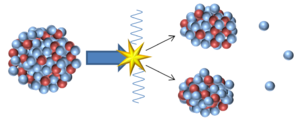Difference between revisions of "Nuclear Fission"
| Line 14: | Line 14: | ||
|[[File:InducedFission.png|center|600px]] | |[[File:InducedFission.png|center|600px]] | ||
|- | |- | ||
| − | | style="height:20px; width:600px; text-align:left;" |A [[model]] showing a possible mechanism for induced '''nuclear fission'''. | + | | style="height:20px; width:600px; text-align:left;" |A [[model]] showing a possible mechanism for induced '''nuclear fission''' resulting from the capture of a [[Thermal Neutron|thermal neutron]]. |
| + | |||
| + | <math>{}_{92}^{235}U + {}_{0}^{1}n \rightarrow {}_{92}^{236}U \rightarrow {}_{36}^{85}Kr + {}_{56}^{148}Ba + 3{}_{0}^{1}n</math> | ||
|} | |} | ||
Revision as of 15:55, 10 March 2019
Key Stage 4
Meaning

An model of nuclear fission.
Nuclear fission is a process in which a large unstable nucleus splits into two more stable nuclei.
About Nuclear Fission
- Nuclear fission occurs when a massive nucleus is so unstable that it splits in two.
- During nuclear fission neutrons are also emitted.
- Nuclear fission transfers energy from the nuclear potential energy store into the thermal energy store of the material and the surroundings.
- Nuclear fission can be induced in a material by bombarding massive nuclei with neutrons. If a neutron is captured by the nucleus it becomes so unstable that it splits in two.
- The neutrons used to induce fission must have a low energy to be captured by a nucleus otherwise the neutrons will just pass straight through without being captured. Neutrons with the right amount of energy to be captured are called thermal neutrons because they have a similar energy to molecules in the air at room temperature.
| A model showing a possible mechanism for induced nuclear fission resulting from the capture of a thermal neutron.
\({}_{92}^{235}U + {}_{0}^{1}n \rightarrow {}_{92}^{236}U \rightarrow {}_{36}^{85}Kr + {}_{56}^{148}Ba + 3{}_{0}^{1}n\) |
